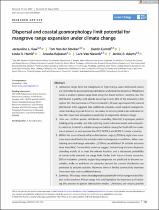| dc.contributor.author | Rajkaran, Anusha | |
| dc.contributor.author | Raw, Jacqueline L | |
| dc.contributor.author | Van der Stocken, Tom | |
| dc.date.accessioned | 2024-02-15T10:22:27Z | |
| dc.date.available | 2024-02-15T10:22:27Z | |
| dc.date.issued | 2022 | |
| dc.identifier.citation | Raw, J.L., Van der Stocken, T., Carroll, D., Harris, L.R., Rajkaran, A., Van Niekerk, L. and Adams, J.B., 2023. Dispersal and coastal geomorphology limit potential for mangrove range expansion under climate change. Journal of Ecology, 111(1), pp.139-155. | en_US |
| dc.identifier.issn | 00220477 | |
| dc.identifier.uri | http://hdl.handle.net/10566/9315 | |
| dc.description.abstract | Latitudinal range limits for mangroves on high-energy, wave-dominated coasts are controlled by geomorphological features and estuarine dynamics. Mangroves reach a southern global range limit along the South African coastline, but the distribution is patchy, with stands occurring in only 16% of the estuaries in the region. Yet, the ersistence of forests planted >50 years ago beyond the natural distribution limit suggests that additional estuaries could support mangroves. Understanding regional drivers is necessary to inform global-scale estimates for how this important ecosystem is predicted to respond to climate change. Here, we combine species distribution odelling (MaxEnt), Lagrangian particle tracking using an eddy-and tide-resolving numerical ocean model, and connectivity matrices, to identify suitable mangrove habitats along the South African coastline at present, as well as under the IPCC RCP4.5 and RCP8.5 climate scenarios. Within the current South African distribution range (±900 km), eight more estuaries were identified to be suitable under contemporary conditions. When considering potential range extension (±110 km), an additional 14 suitable stuaries were identified. Connectivity matrices suggest limited long-distance dispersal, stranding mostly at or near the release location, and a decreased probability of connectivity towards the range limit. Under both future climate scenarios, 30% of estuaries currently supporting mangroves are predicted to become unsuitable, while an additional six estuaries beyond the current distribution are predicted to become suitable. However, there is limited connectivity between these new sites and established forests. Synthesis. This study shows that dispersal substantially limits mangrove distribution at the southern African range limit and highlights the importance of including this process in species distribution models. Ultimately, our results provide new insight into mangrove conservation and management at range limits that are not controlled predominantly by temperature, as it has been assumed that mangroves will largely expand to higher latitudes under climate change. | en_US |
| dc.language.iso | en | en_US |
| dc.publisher | John Wiley and Sons Inc | en_US |
| dc.subject | Avicennia marina | en_US |
| dc.subject | Climate change | en_US |
| dc.subject | Coastal wetland | en_US |
| dc.subject | Dispersal limitation | en_US |
| dc.subject | Lagrangian particle tracking | en_US |
| dc.title | Dispersal and coastal geomorphology limit potential for mangrove range expansion under climate change | en_US |
| dc.type | Article | en_US |

